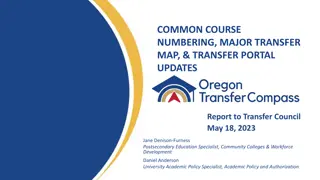Understanding Time Transfer Statistics in Technical Services
Time transfer in technical services involves transmitting time information between locations, with a focus on statistical measures like Time Deviation (TDEV). This process assesses the noise affecting systems using specialized tools for time and frequency stability analysis. The performance of time transfer systems is crucially influenced by factors such as accuracy, noise, drift, and environmental sensitivities. Models and measurements help in evaluating system deviations and outliers, while defining fractional frequency deviations provides key insights into system behavior.
Download Presentation

Please find below an Image/Link to download the presentation.
The content on the website is provided AS IS for your information and personal use only. It may not be sold, licensed, or shared on other websites without obtaining consent from the author. Download presentation by click this link. If you encounter any issues during the download, it is possible that the publisher has removed the file from their server.
E N D
Presentation Transcript
The Statistics of Time Transfer W.J. Riley 2016 Precise Time and Time Interval (PTTI) Meeting Monterey, CA USA Tutorial January 25, 2016 Hamilton Technical Services 650 Distant Island Drive Beaufort, SC 29907 USA Telephone: 843-525-6495 Fax: 843-525-0251 E-Mail: bill@wriley.com Web: http://www.wriley.com Rev A 02/12/16
Introduction Hamilton Technical Services Time transfer is the process of transmitting time information from one place to another. It can also be used to convey frequency information since frequency is the rate of change of phase. The performance of a time or frequency transfer system can be characterized by several specialized statistical measures. Those measures are based on the properties of the underlying noise affecting the system, based on certain definitions and statistical tools used for the analysis of time and frequency stability. As we shall see, the principle measure of the noise associated with a time transfer is the Time Deviation, TDEV. January 25, 2016 The Statistics of Time Transfer 2
A Time Transfer System Hamilton Technical Services A representative one-way time transfer system is shown below: The time at the far end is subject to variations caused by the frequency source, the clock, TX & RX circuits and the transmission medium whose noise properties we wish to describe. January 25, 2016 The Statistics of Time Transfer 3
Time Transfer Performance Hamilton Technical Services Accuracy Noise, Scatter, Jitter, Variability The Main Topic of this Talk - Statistics Drift, Wandering A Secondary Topic of this Talk Fits & Models Environmental Sensitivity, TC, EMI Similar Measurements Used to Assess Sensitivities Jumps, Lurches, Glitches, Outliers Must Be Dealt With to Analyze Noise, etc. Positioning, Calibration, Error Budget January 25, 2016 The Statistics of Time Transfer 4
Definitions Hamilton Technical Services A time transfer system can be modeled as a sinusoidal signal whose phase is measured at a remote location. We are primarily interested in the phase deviation, (t), and the corresponding time deviation x(t)= (t)/2 0 We can also define the fractional frequency deviation as: January 25, 2016 The Statistics of Time Transfer 5
Time Transfer Noise Hamilton Technical Services The frequency source, clock, transmitter & receiver circuits, and the transmission medium can be considered to have noise mechanisms that have power law spectral densities and corresponding time domain statistical properties of their frequency fluctuations: Power Law Exponent, 0 -1 -2 -3 Noise Type White Flicker Random Walk Flicker Walk January 25, 2016 The Statistics of Time Transfer 6
Power Law Noise Hamilton Technical Services January 25, 2016 The Statistics of Time Transfer 7
More Power Law Noise Hamilton Technical Services =0 White Noise =-1 Flicker Noise =-2 Random Walk Noise =-1.5 Flicker/RW Noise January 25, 2016 The Statistics of Time Transfer 8
Time Domain Stability Statistics Hamilton Technical Services Standard Deviation Familiar, But Doesn t Converge for < 0 Allan Deviation Most Commonly Used Measure of Frequency Stability Modified Allan Deviation Especially Suitable for Analyzing Phase Fluctuations Time Deviation Preferred Measure of Time Interval Error Based on Modified Allan Deviation TIE rms Another Common Measure of Time Interval Error January 25, 2016 The Statistics of Time Transfer 9
Standard Deviation Hamilton Technical Services Convergence of Standard & Allan Deviation for Flicker FM Noise 3.0 Standard or Allan Deviation 2.5 Blue=Std Dev Red=ADEV 2.0 1.5 1.0 10 100 1000 Sample Size (m=1) January 25, 2016 The Statistics of Time Transfer 10
Allan Deviation, ADEV Hamilton Technical Services The 2-sample or Allan variance is the preferred measure of frequency stability, whose basic estimator is given by: 1st differences of frequency The Allan deviation is y( ) the square root of the Allan variance. In terms of phase data: 2nd differences of phase Other forms of these estimators can provide better confidence. January 25, 2016 The Statistics of Time Transfer 11
Modified Allan Deviation, MDEV Hamilton Technical Services The Modified Allan variance includes an additional phase averaging operation that enhances its ability to distinguish between white and flicker PM noise. Its fully-overlapping estimator is shown here for N phase data points and an averaging factor of m: The MDEV has the same expected value as the ADEV for m=1, and is smaller than ADEV for averaging factor >1. January 25, 2016 The Statistics of Time Transfer 12
Time Deviation, TDEV Hamilton Technical Services The time variance, TVAR or 2x( ), is based on the Modified Allan variance, and the time deviation, TDEV or x( ), is its square root. The scaling factor makes TDEV equal to the standard Variance of the time deviations for white PM noise. TDEV is the product of a frequency deviation (a rate of change of a phase) times time, where the frequency deviation term distinguishes between white and flicker PM noise, and is scaled so that it equals the classical standard deviation of the phase fluctuations for white PM noise at = 0. January 25, 2016 The Statistics of Time Transfer 13
RMS Time Interval Error, TIE rms Hamilton Technical Services The rms time interval error, TIE rms, is another measure of time variability. For no frequency offset, it is approximately equal to the standard deviation of the fractional frequency fluctuations multiplied by the averaging time. TDEV is, however, a better measure of time deviation for divergent noise types. January 25, 2016 The Statistics of Time Transfer 14
SigmaTau Plot Hamilton Technical Services January 25, 2016 The Statistics of Time Transfer 15
Mod SigmaTau Plot Hamilton Technical Services January 25, 2016 The Statistics of Time Transfer 16
TDEV Tau Plot Hamilton Technical Services January 25, 2016 The Statistics of Time Transfer 17
Summary of Stability Plot Noise Slopes Hamilton Technical Services Noise Type Stability Plot Noise Slope ADEV MDEV -1 -3/2 -1 -1 -1/2 -1/2 TDEV -1/2 0 +1/2 White PM Flicker PM Random Walk PM or White PM Flicker FM Random Walk FM +2 +1 0 -1 -2 0 0 +1 +3/2 +1/2 +1/2 January 25, 2016 The Statistics of Time Transfer 18
Time Transfer Measurements Hamilton Technical Services Examples: Ethernet or coax cable, spool of optical fiber Resembles WWV, Loran, 1-way GPS Resembles NTP, GPS CV,TWSTFT January 25, 2016 The Statistics of Time Transfer 19
Examples of Time Transfer TDEV Plots Hamilton Technical Services Credit: V. Zhang, T. Parker & M. Weiss/NIST 39th PTTI Meeting, 2007 Credit: D. Matsakis/USNO 2009 Time Transfer Tutorial Material The performance of a time transfer system is commonly shown as a plot of TDEV versus averaging time. January 25, 2016 The Statistics of Time Transfer 20
Example of a GPS T/F Transfer Hamilton Technical Services The GPS disciplined oscillator produces a smoothed 10 MHz output from an internal TCXO locked to the GPS timing signal. The time interval counter measures the relative phase of the Rb oscillator versus the GPSDO at 1 second intervals. Those data are used to determine the frequency offset of the Rb oscillator and allow it to be calibrated against GPS. The GPSDO also provides UTC data and a smoothed 1 PPS clock output. January 25, 2016 Rev A 02/12/16 The Statistics of Time Transfer 21
GPS Disciplined Rb Oscillator Hamilton Technical Services Example of a GPS Disciplined Rubidium Oscillator Credit: Stanford Research Systems A Rb GPSDO can maintain timing to 20 ns and frequency to 1e-13 at 1 day January 25, 2016 The Statistics of Time Transfer 22
GPSDO Phase Record Hamilton Technical Services January 25, 2016 Rev A 02/12/16 The Statistics of Time Transfer 23
GPSDO Phase Residuals Hamilton Technical Services January 26, 2016 Rev A 02/12/16 The Statistics of Time Transfer 24
GPSDO Frequency Record Hamilton Technical Services January 25, 2016 Rev A 02/12/16 The Statistics of Time Transfer 25
GPSDO ADEV Hamilton Technical Services January 25, 2016 Rev A 02/12/16 The Statistics of Time Transfer 26
GPSDO MDEV Hamilton Technical Services January 25, 2016 Rev A 02/12/16 The Statistics of Time Transfer 27
GPSDO TDEV Hamilton Technical Services January 25, 2016 Rev A 02/12/16 The Statistics of Time Transfer 28
References Hamilton Technical Services 1. W.J. Riley, Handbook of Frequency Stability Analysis, NIST Special Publication 1065, National Institute of Standards and Technology, July 2008. 2. M.A. Lombardi, L.M. Nelson, A.N. Novick and V.S. Zhang, Time and Frequency Measurements Using the Global Positioning System , Cal Lab, July-September 2001, pp. 26-33. 3. D.W. Allan, D.D. Davis, J. Levine, M.A. Weiss, N. Hironaka and D. Okayama, New Inexpensive Frequency Calibration Service from NIST , Proc. 44th Freq. Cont. Symp., pp. 107-116, May 1990. January 25, 2016 The Statistics of Time Transfer 29























